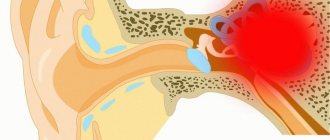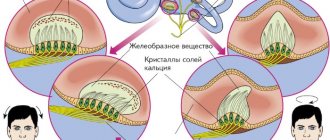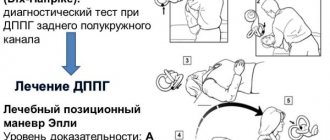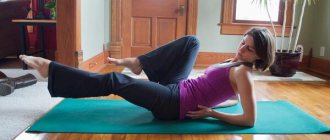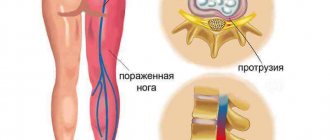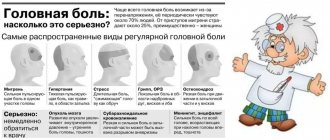In patients with benign vertigo, the inner ear is affected. This is accompanied by paroxysmal dizziness, which worsens the quality of life. Gymnastics for vestibular vertigo is a specially designed set of exercises that patients can perform independently at home. This is the main therapy method that was developed by doctors Brandt-Daroff and Epley-Simon.
Properly selected rehabilitation treatment has a better therapeutic effect than medications. Before starting training, it is necessary to exclude tumor processes and ischemic brain damage. Otherwise, the underlying disease will progress and the patient’s well-being will deteriorate.
Essence and basic principles
Brandt-Daroff vestibular gymnastics is one of the most effective techniques that helps speed up the compensation process and get rid of the unpleasant symptoms of dizziness. This set of exercises is often recommended for patients with BPPV (benign paroxysmal positional vertigo).
BPPV occurs when small crystals of calcium carbonate that form in the ear canals are released and move into the semicircular canals of the ears. This reaction sends mixed signals to the brain about the position of the body, and as a result, dizziness occurs.
But special exercises help break and knock out crystals, alleviating the symptoms of dizziness.
Brandt-Daroff exercises have a lot of positive aspects:
- with regular exercises, it is possible to gradually remove otolith particles from the semicircular canal in the vestibule of the labyrinth;
- during exercise, otolith particles can gradually dissolve in the endolymph;
- the maximum effect can be achieved thanks to the phenomenon of habituation: repeated provocation of dizziness leads to a significantly reduced likelihood of the central nervous system responding to an irritating factor.
Gymnastics helps restore the damaged organ of balance and helps to gradually adapt to the conditions of the outside world. This technique is quite effective, but gymnastics should be performed exactly as recommended by the doctor. It is in this case that you can achieve a positive result for a long time.
If you follow all the recommendations, vestibular exercises will help:
- reduce the likelihood of injury from a fall if you suddenly feel dizzy;
- remove symptoms of nausea and dizziness;
- improve and increase blood flow to the organs of the spinal cord and brain;
- improve quality of life;
- normalize coordination of movements;
- improve vision.
For older people, gymnastics helps them better navigate in space and maintain balance.
Such exercises not only have a positive effect on all organs of the human body, but also prepare the body for possible falls. As a result of this, the person will receive a minimal amount of injury if a situation suddenly arises.
Complications of benign paroxysmal positional vertigo
BPPV itself has a favorable course, but if an attack of systemic dizziness occurs when a person is at great heights, depths, or while driving, then it can be dangerous. For example, such dizziness can cause a fall and injury.
The main complications and discomfort with BPPV are associated with the vestibular system. Autonomic disorders such as sweating and tachycardia are often observed. Patients experience prolonged minor instability both after an attack and after successful treatment.
Multichannel BPPV is one of the most severe complications. It can develop either after a head injury or after repositioning techniques—removal of otoliths and their particles from the canals. Crystals fall not only into the affected channel, but also into neighboring ones. This leads to severe irritation of the vestibular apparatus.
Do not forget that BPPV itself is a complication of other diseases, most often traumatic brain injury. It can be disguised as clinical manifestations of other diseases and injuries - vestibular neuronitis, heart attack or labyrinthine hydrocele. To distinguish BPPV from these disorders, it is necessary to take a competent approach to diagnosis.
Indications for use
Brandt-Daroff vestibular gymnastics helps to concentrate attention, but does not train muscles. This type of exercise is recommended for use by all people, including the elderly, who suffer from frequent attacks of dizziness.
This set of exercises is shown to people:
- those who have had a stroke;
- those suffering from BPPV;
- with general impaired coordination of movements;
- with osteochondrosis;
- with high numbers on the tonometer;
- with chronic migraine;
- with mental disorders;
- with lung pathologies
- with minor and serious spinal injuries;
- with dyscyclic encephalopathy;
- having pathologies affecting the ear areas.
Brandt-Daroff vestibular exercises are also recommended for people who have suffered a history of brain injury.
What can the doctor say?
In order to determine the cause of dizziness, you need to visit a specialist - a therapist or neurologist . They will examine the patient, prescribe additional tests, or refer you for a consultation to another doctor. You will also have to do an electrocardiogram and a blood test.
It happens that doctors do not find any diseases in a person suffering from dizziness. But this does not mean that you went to the doctors in vain. After all, they ruled out the development of dangerous ailments in you, such as heart disease or cancer. Therefore, you can engage in disease prevention with a light heart.
Contraindications for use
Vestibular gymnastics performed at home is very beneficial for the human body. But before you start doing exercises using the Brandt-Daroff method or using any other method, you should definitely consult a doctor. Such activities have a number of contraindications, and if they are not taken into account, then the patient’s already serious condition can be aggravated.
You cannot use gymnastics if:
- serious disturbances in breathing rhythm are observed;
- the patient’s medical history contains records of heart problems;
- The patient has a cold or infectious disease.
Useful tips for patients
Vestibular gymnastics will be most effective if you follow a number of basic rules:
- The exercises should be performed in a well-lit room, so that there are no objects with sharp corners nearby, and a carpet without any folds that could lead to a fall and injury to the patient.
- The maneuver is performed using soft surfaces, such as a yoga mat, mat, blanket or thick mat.
- You need to choose comfortable clothing so that it does not constrain or limit movement. But it should not be too wide so that the patient does not get confused in it.
- Shoes must be flat-soled.
- While doing gymnastics, there must be a coach or a loved one nearby who can come to the rescue if necessary.
- You should not overload your body; as soon as even a slight feeling of fatigue appears, you need to stop.
- The load should be increased gradually to prepare the body and prevent relapses.
- Regularity is also important.
- If the patient is feeling unwell, it is better to postpone performing gymnastics until the condition improves.
- Gymnastics is not a separate type of treatment; it will only be beneficial in combination with drug treatment.
BPPV: causes of vertigo, diagnosis and treatment, Brand Daroff exercise
About 75% of people who suffer from vertigo actually experience it due to a disease of the inner ear and vestibular system.
BPPV or benign paroxysmal (frequently recurring) positional (starts in a certain position of the body) vertigo is characterized by sudden attacks of dizziness due to changes in head position or body posture.
According to statistics, about 40% of people over the age of 50 suffer from this disorder. Also, women complain much more often about its manifestations. The disease mainly manifests itself during physical activity, during morning rises, etc.
Benign vertigo (BPPV)
Benign paroxysmal positional vertigo is an attack-like vertigo that originates in the inner ear. It lasts for several days or weeks. Once the symptom disappears, it may reappear.
Benign positional vertigo syndrome is not associated with functional impairment, brain disorders, changes in the cervical spine, blood pressure, or other health problems. This is the most common type of peripheral vertigo.
Etiological factors in the development of functional dizziness (causes)
Benign paroxysmal positional vertigo (BPPV), a very complex condition in etiology, in some cases it is not possible to establish the true cause of the disease.
The most common causes of BPPV include:
- traumatic injuries of the skull and concussions;
- inflammatory processes in the labyrinth of the inner ear;
- undergone surgical interventions in the head area.
Features of symptomatic manifestations
Symptomatically, benign paroxysmal vertigo manifests itself in the form of a feeling that objects around are rotating, this feeling appears after a sudden change in body position.
Paroxysmal dizziness usually manifests itself in the morning after sleep; it is difficult for a person to navigate in space after getting out of bed.
The duration of the paroxysmal period is, as a rule, no more than three minutes, then it goes away on its own without the use of auxiliary techniques.
Additionally, benign paroxysmal positional vertigo manifests itself in the form of dyspeptic disorders, which is a common symptomatic component for all types of vertigo.
An important aspect in diagnosing the disease is that benign positional vertigo is not accompanied by syndromes of organic disorders of the nervous system.
With this pathology, no pathologies develop in the organs of hearing, vision or smell. Thus, the disease does not pose a particular threat to human life, but causes some discomfort.
The structure of the vestibular apparatus and the nature of BPPV
The term "dizziness" is not precisely defined, but it is used to describe feelings such as:
- leaning to the side;
- lack of confidence when walking;
- feeling of impending fall;
- balance disorder (swaying, weakness, darkness before the eyes).
Dizziness is sometimes accompanied by a number of symptoms, including:
- nausea;
- sweating;
- nystagmus;
- walking disorder (ataxia);
- heartbeat;
- other vegetative symptoms.
The equilibrium device (vestibular apparatus) consists of several subsystems that work effectively only in harmony. Receptors that respond to a specific stimulus include:
- direct equilibrium device = labyrinth located in the inner ear;
- visual apparatus;
- deep perception receptors;
- through the corresponding nerve, information from these receptors is transferred to the centers that process signals (the centers mainly belong to the area of the vestibular nuclei in the brain stem and cerebellum).
The ability to maintain balance depends on the correct response of the central nervous system to the information received. In practice, the division into peripheral and central systems is important. The peripheral balance device is located in the pyramid of the temporal bone.
It is an integral part of the structure of the inner ear, with which it is organically connected.
The central equilibrium device is created by connecting several brainstem and subcortical brain stems, connecting them to other areas (eyes, muscles, spine, etc.).
Forecast
The prognosis for recovery is usually favorable; this condition does not pose a particular danger to the patient’s life. Depending on what disease or injury could have triggered the development of this condition, further recovery and the effect of the treatment will depend.
The prognosis for full recovery also depends on how promptly the patient sought qualified medical help.
Source: https://neuro-orto.ru/bolezni/epylepsyya/manevr-epli.html
Main complex
This type of vestibular gymnastics can also be performed at home, since it does not provoke any negative reactions in the body of a person suffering from frequent attacks of dizziness.
Outside help in performing the exercise is not required, but it is better if someone is nearby, because it is unknown how the human body will react, this is especially important when performing the maneuver for the first time.
The patient should take a sitting position, you can use a regular table or ottoman, and your feet should be on the floor or simply dangling. You can just sit on the bed.
Brandt-Daroff vestibular gymnastics
And after the movement it should be like this:
- When a person calms down and feels comfortable in a sitting position, he will need to lie on his right or left side.
- You need to turn your head up, maintaining an angle of 45 degrees.
- Fix in this position for 30 seconds.
- Next, the person must again take a sitting position and stay in it for half a minute.
- Afterwards you need to repeat the procedure, but lie on the opposite side.
This is how you need to do 5 repetitions on each side. You need to rest for 15 seconds between repetitions.
If a person does not experience dizziness during the exercise, then the maneuver should be repeated, but only after a day. If dizziness occurs even for a short time in any of the positions, then the maneuver should be repeated at least 2 more times, in the evening, and then in the morning.
Vestibular exercises work in several directions at once. Their main essence is an increased supply of stimuli to the nerve endings of the central part of the vestibular apparatus, which are localized in the area of the brain stem.
gymnastics every morning for 1-2 months
- In a lying position, you need to move your eyes first horizontally, and then vertically, bring your eyes closer together, and direct your gaze to the tip of the finger approaching your nose.
- Next, you need to add gradually accelerating head movements, initially doing everything with your eyes open, and then with your eyes closed.
- Afterwards, in a sitting position, you need to turn your head, bend over, and do everything first with your eyes open, and then with your eyes closed.
- Later, you can add throwing a small ball from one hand to the other, and then complicate the task by throwing the ball under the knee.
- Next, you can add squats, also closing and then opening your eyes. As soon as all the exercises go well, without any unpleasant symptoms, you can move on to twisting your torso.
- Afterwards you need to walk on a flat surface with your eyes open and closed. You can add head turns while walking.
This whole complex helps to better navigate in space and protect against dizziness.
Eye tracking
Sit in a comfortable position, take in your hand a small (the size of a postcard or map) thick piece of paper with a few words printed on it in regular font. Hold a piece of paper 30 cm away at eye level. Move the piece of paper horizontally to the right and left. Repeat the exercises, moving the sheet vertically, then diagonally. During the exercise, the head should remain motionless; you need to follow the leaf only with your eyes. Over time, move the piece of paper faster and faster until you can no longer make out the words written on it.
In each plane you need to repeat the exercise 15–20 times.
Consolidate the result
Today, in the world of modern technology, dizziness is mainly treated without the use of medications. Oral medications may be prescribed if the patient is experiencing an acute period when the person’s standard of living has reached critical levels and dizziness is also accompanied by nausea and a gag reflex.
Drug treatment helps alleviate the condition and improve the condition of life.
The patient may be prescribed the following medications:
- Dramamine. This is an antihistamine that inhibits the vestibular apparatus of the inner ear, affecting primarily the otoliths. The medicine has an antiemetic, sedative, anorexigenic effect, and eliminates dizziness. Take 1 tablet. up to 3 times a day. The duration is set individually. A package of 10 tablets will cost an average of 300 rubles.
- Cinnarizine. This medicine belongs to the group of vasodilators and effectively helps with migraines and dizziness. For each disease, and the drug can be prescribed for pain relief and treatment of vascular pathologies, the dosage and course are selected individually. The standard dosage for the treatment of dizziness is 1 tablet up to 3 times a day. It should be taken only after meals, as the drug can irritate the gastric mucosa. The average price for 1 unit of goods is 100 rubles.
Cinnarizine tablets - Vestibo. This is a drug from the group of vestibulolytics, prescribed to people suffering from attacks of dizziness. The medicine has similar properties to histamine, improves the flow of blood into the basilar arteries, slowing down the work of some prescriptions and relieving the symptoms of dizziness, and has a positive effect on the brain stem. Packaging the drug will cost an average of 200 rubles.
- Tanakan. This is a drug from the group of herbal nootropics. Helps improve all metabolic processes in the body, improves blood flow, increases blood flow to the brain, normalizes vascular tone, and stops the active development of thrombosis. Take the drug 1 pill three times a day. The average cost of the drug is from 500 rubles.
- Cerucal. This is an antiemetic. Acute dizziness often causes bouts of vomiting, and Cerucal helps eliminate them. The dose and course are selected individually, taking into account contraindications and features of the course of the disease. The average cost of the drug is from 200 rubles.
But doctors use positional maneuvers as the primary treatment for dizziness. Their action is to change the position of the patient’s body and head in space. It is thanks to such exercises that it is possible to move the otoliths, located in the ear canals, to the part of the vestibular apparatus, where they should be. BPPV attacks may occur during such maneuvers.
There are several such maneuvers that you can perform independently without the help of a specialist at home, including the Brandt-Daroff maneuver, and there are also those that must be supervised by a doctor or trainer.
The table below shows several maneuvers that can help relieve dizziness. They are recommended if Brandt-Daroff vestibular gymnastics did not produce the desired results or there are contraindications to its use.
| Maneuver | Execution Features |
| Semonta | This technique is quite effective, but it is better to perform it in the presence of a doctor, because during it an attack of dizziness may occur that will need to be stopped. The maneuver is performed in a sitting position, with your feet on the floor. The patient turns his head 45 degrees to one side, all movements are slow, without jerking. The doctor fixes the head in this position, and the patient takes a position lying on his side and stays there for 2 minutes. Afterwards the patient returns to the original position. They repeat the maneuver, only turning their head and lying down on the other side. |
| Epley | This maneuver is also performed in the presence of a medical professional. The patient should assume a sitting position. Feet are on the floor, head is turned to the side 45 degrees. The medical worker fixes the head, and the patient lies on his back, throwing his head back as far as possible, hold for 1 minute. Next you need to turn your head in the other direction, and then the person turns his whole body on its side. Hold again for 30 seconds, and then return to the starting position. |
| Lempert | This type of gymnastics is very similar to the Epley maneuver. The main difference is that after the body turns on its side, its movement does not stop. The body must continue to rotate around its axis. |
All the maneuvers described above are often used to treat dizziness; there are a number of others, but as practice has shown, it is the 4 described that give the best effect. Treatment usually lasts no more than a week, but most often it goes away faster.
In the most difficult cases, surgery for dizziness can be used:
- labyrinthomia – used for the chronic stage of Meniere’s disease;
- ototoxic antibiotics - effective for Meniere's disease;
- neurovascular decompression – for vestibular paroxysm;
- surgery to remove neuroma;
- perilymphatic fistula surgery.
Body Control Exercises
Exercises for dizziness also include workouts that improve body control.
Walking on uneven terrain
The purpose of such activity is to restore and maintain body balance. It consists of walking barefoot along a marked route consisting of different types of surfaces, complemented by artificial inequalities.
An “obstacle path” indoors or outdoors can be formed, for example, from the following elements:
- various pads;
- natural or artificial grass;
- sand;
- rubber mats;
- wooden, metal, plastic, textile elements.
Important! The benefit of this activity is that you can do it anywhere: on a walk or even during a barbecue with friends.
Balancing positions
First phase of training: it is important to find your relaxed but stable position. The head is positioned straight, the neck is relaxed. Hips, knees and legs are in the same plane as much as possible.
The following materials are used as auxiliary materials:
- rubber balls;
- bags of beans or peas;
- footbag;
- various sponges or other safe material.
You should try to place one of the above-mentioned objects on different parts of the body and in different positions, balancing them so that they do not fall on the floor. Balance with the object on your fingers, palm, forearm, shoulder, etc.
You can make the exercise more difficult by balancing with an object on your knee, shin, or placing the object on your head and walking slowly.
When to expect an effect
As experts and patients themselves say, a positive result after using gymnastics using the Brandt-Daroff method can be expected after completing the first set. You need to perform the maneuver 5 repetitions each morning, afternoon and evening.
Each set should take no more than 10 minutes. If an episode of dizziness has occurred, then it is better to perform the maneuver for 2 weeks. But doctors say that within a day after the gymnastics, the patient’s condition improves significantly.
Vestibular gymnastics, regardless of which of the Brandt-Daroff or Epley maneuvers was used, is a safe and most effective way to independently reduce, and in some cases completely get rid of, the symptoms of dizziness.
If maneuvers do not help, then it is better to seek qualified help. The doctor will help you choose a different set of exercises and, if necessary, prescribe medication.
Exercises according to the Strelnikova scheme
Breathing therapeutic exercises by A. N. Strelnikova are aimed at improving the condition of the body; in general, it will also help against dizziness by alleviating the underlying disorder (especially for cardiac and vascular causes).
At the end of each turn or bend (squat), take a sharp breath through your nose. Exhalations are light and smooth.
Basic movements:
- Turn the head in each direction.
- Head tilts to each side.
- Tilts the head forward and backward.
- Squats with lunges.
- Bend forward and backward.

